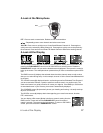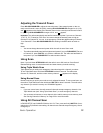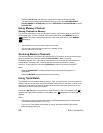25
3. Once sent, the radio monitors transmission between CH 16 and CH 70. until it receives an
acknowledgement signal (ACK)
4. The radio sounds an alert which lasts between 210 and 270 seconds. The sound ceases
upon receipt of an ACK.
Notes:
• If your radio receives a DSC call from another radio, any message on your screen is
replaced with the new one.
• If you press any key while there is a message displayed, the message disappears.
• The alert tone starts at a reduced volume and gradually becomes louder, reaching a max-
imum level after 10 seconds.
• The DCS tone for Routine or Distress stop automatically after 2 minutes when STANDBY
mode is OFF. The Routine tone stops after 5 seconds while the Distress tone stops after
30 seconds when STANDBY is ON.
• When the radio receives a DSC call, it takes priority and all other modes/functions such
as SCAN, TRIPLE WATCH, WX, WX ALERT and EMG are cancelled.
Receiving a DSC Distress Call
If the radio receives a DSC distress call, it sounds a distress tone up to 2 minutes. If the
name of the vessel sending the distress call is programmed into the radio, the vessel’s name
appears. Otherwise, the vessel’s MMSI, position, time, and the nature of their distress
appear.
The Radio Menu Settings for DSC Call and Fog Horn
To enter settings for DSC CALL and FOG HORN options, press MENU/HELP while the radio
is tuned to a frequency. A
RADIO MENU screen appears listing DSC CALL, FOG HORN
and
EXIT.
Rotate PUSH/SELECT to highlight the desired item, then press PUSH/SELECT to select it.
Unless you have no Fog Horn connected, you see several optional setting that you can make
for each item. Without a Fog Horn connected, you see
HORN IS NOT CONNECTED. To
return to the previous menu, press MENU/HELP. To exit, rotate PUSH/SELECT to select
EXIT then press PUSH/SELECT. The following chart shows the radio menu options with a
Fog Horn connected.
Basic Operation


















